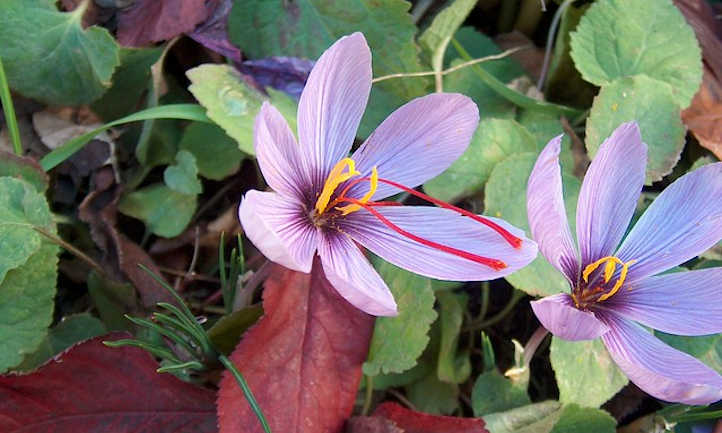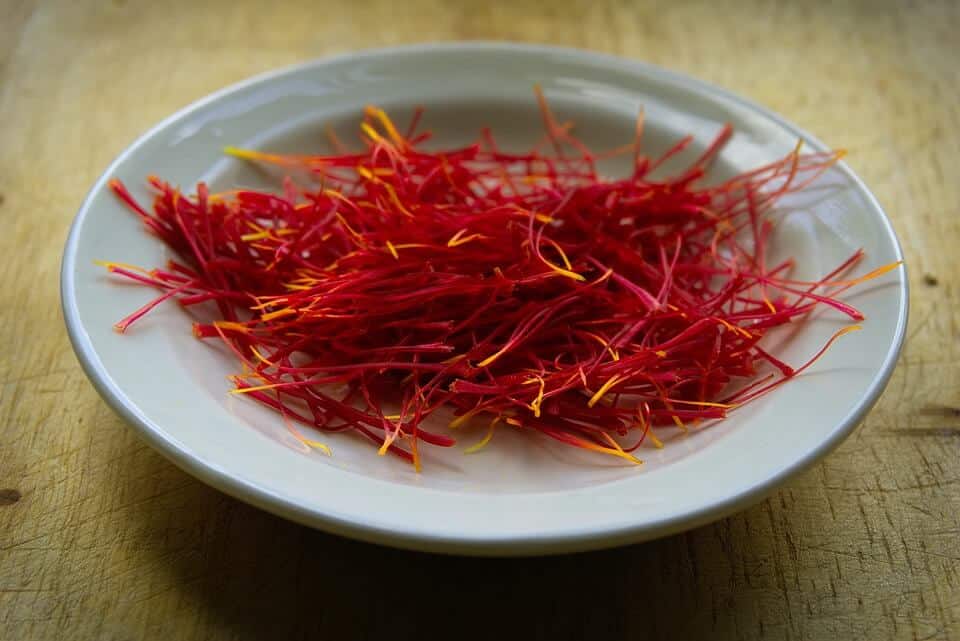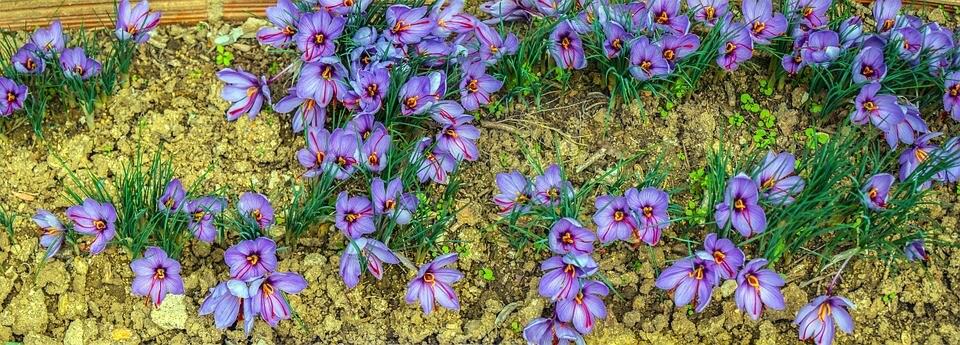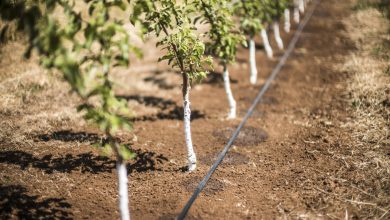How to Plant Saffron in a simple and effective way

to saffron Also known as «El Oro de la Mancha».
Why is he known like this?
For its price. It costs a lot.A kilo of saffron can cost €5,000.
And… Why does it cost so much?
Two reasons:
- because it is aEXTRAORDINARY flavor enhancer. Its filaments give an extra flavor (almost miraculous) to food.
- Its harvest requires a lot of work.
But if you have come this far, it is because you are interested in planting saffron. Your own saffron. Either for self-consumption or to sell.
Well, I think we can help you. Read on.
Step by Step to Plant Saffron:
- When? Between June and September.

- Where? Dry and sunny climates. Requires sunlight.
- How long does it take to harvest? About 30 days after sowing.
- How do we prepare the land? Clay soil. not heavy The pH between 6 and 8. Removed with a power tiller.
- What type of subscription do you require? Compound fertilizer about 20 cm from the surface. Three months before sowing.
- How do we water? Ideal drip, but not essential. With hose without flooding.
- How often do we water? It doesn’t need a lot of water. Rainwater itself is enough, except in summer.
- How do we sow? Acquire saffron bulbs and bury them about 15-20cm deep. Leave a space of 10cm between them.
- What do we NOT plant nearby? Potato, carrot, turnips, alfalfa.
- How do we collect? Extracting the red strands or filaments of the pistil.
- What pests and diseases does it have? Rhizoctonia violacea and Fusarium sp.
Saffron is a flower, whose scientific name is Crocus sativus. This plant is highly appreciated thanks to its wide and varied medicinal, ornamental and culinary properties.
It is physically recognized for beinga flower with 6 purple petals, three golden yellow stamens and a red pistil. This pistil is the one that dries and gives the saffron in spice.
This plant is known worldwide for its exotic reputation, however its cultivation is really simple, as is its maintenance, since it is not a species of demanding conditions nor is it prone to the spread of insects, although as will be detailed later the pests that attack it are deadly.
Its demand for attention is marked and simple, planting in the summer, harvesting the flowers in the fall.
 The saffron, as the saffron plantation is known, although it is a «child’s game» requires patience since its harvest will gradually increase over the years.
The saffron, as the saffron plantation is known, although it is a «child’s game» requires patience since its harvest will gradually increase over the years.
Thus, the first year a maximum of 2 flowers per bulb will be obtained, but in the third year the production can be8 or more flowers each.
It is not recommended to leave the planting for more than four years.
Unlike other plants, saffron is not planted from a seed but from a bulb. Harvesting is recommended during the first hours of the morning, when the flower is still closed.
The fresh filaments that contain the saffron flowerscan be used immediately in the kitchenor they can be kept in airtight containers, protected from light.
If storage is decided, they should be dried beforehand by placing the filaments on a paper towel for a couple of days in a cool, dry place.
Why is saffron so expensive?
Saffron is tremendously expensive not because of its cultivation, butfor his harvest.
It requires a lot of human labor to collect the filaments that the saffron flower produces and that are then used in many cooking recipes.
How much does a kg of saffron cost?
It depends on the region. In Europe you can reachworth about 20 thousand euros per kilogram.. In the case of Mexico and Latin America, 50 thousand pesos.
We need about 150 thousand flowers to obtain 1kg of saffron. With one hectare you can get between 15 and 20kg. It is estimated that the yield per hectare usually reaches €30,000-40,000.
There is a lot of bad competition in the saffron sector, since there are countries like Iran, Greece or Morocco that export it at a much cheaper price than saffron from La Mancha. However, they are not required to put the origin of the saffron on the label.
This means that the prices are much lower than those of La Mancha saffron, but also the quality of the species. Although they are then sold to the final consumer at almost the same price.
In the event that your intention is not to sell saffron and you do not have enough land for its cultivation, do not rule out growing saffron in your own urban or home garden and thus be able to enjoy this excellent spice in the kitchen.
When is saffron cultivated?
Saffron is usually grownbetween the months of June to September.
The saffron plant usually blooms in the second half of October or the beginning of November, although everything depends on the weather conditions in the region.
What pick up time do you have?
The collection can be done daily, in the early hours of the morning and once the plant has flowered and is closed. An easy way to determine the exact time of harvest is by noting the filaments.
The saffron plant typically has a flowering period of about 20 days, with an intense period lasting from two to six days, known as the mantle period.
Where is saffron grown?
Sowing saffron is simple and does not require more conditions. The important thing is to have the bulbs. The high value in the price of saffron originates from the labor required.
It is typically planted in rows in geographic locations in dry, sunny climates.
It is important not to use soils in which alfalfa, beets, potatoes, carrots or turnips have been cultivated previously, since these crops are prone to the same pests that attack saffron, so it is advisable to let the land rest for at least 3 years.

What does the earth need?
The land where saffron is grown must be able to filter the water, which is why very clayey and heavy soils are not suitable.
The best soils are those with a permeable consistency, such as silico-argillaceous, silico-calcareous. It also thrives in sandy soils containing organic matter.
As for the pH of the soil, a slightly neutral pH is recommended, with values between 6-8.
Before winter, the soil can be prepared with compost to a depth of about 20 cm. In the case of using nitrogen fertilizer, it will suffice to place it after planting.
It is important that during planting, the temperature is warm between 25 and 35 °C and that the soil has an adequate degree of humidity, not wet but not dry either.
Therefore, it must be prepared in advance, for example by uniformly incorporating between 12,000-20,000 Kg of manure / hectare, at least three months in advance.
How are saffron plants watered?
The saffron plant does not have important requirements during irrigation, as it is adapted to dry climates and depends almost entirely on the water that comes from the rains. However, there are two times of the year when its water requirements are greater, which is why irrigation must be resorted to:
- During the spring (between the months of March-April for the geographical locations of the northern hemisphere and the months of September-October for the southern hemisphere) to favor the formation of the bulbs;
- And in autumn (months of September-October for the regions of the northern hemisphere, March-April in the southern hemisphere) to help the outbreak and flowering.
It is important to take into account that despite the need for an irrigation system on these dates, the irrigation must be sufficient but not abundant, that is, puddles of water should not be produced on the ground, as this will cause root rot.
How should we plant saffron?
Saffron cultivation is not difficult if we know the steps to follow.
The first thing to take into account is the type of soil and its quality. The importance of a healthy soil, without fungal problems, and permeable has already been described.
Subsequently, the bulbs that are going to be planted must be acquired, for this purpose bulbs of good size and quality that can provide a good harvest must be chosen. It is important to clean the soil and any organic matter that may be attached to it.
At the time of preparing the land, a sterilization (incorporation of organic matter such as manure) three months before the planting date is recommended.
 Sowing is done manually and for this the bulbs must be buried 15-20 cm deep, leaving a space of at least 10 cm between each one.
Sowing is done manually and for this the bulbs must be buried 15-20 cm deep, leaving a space of at least 10 cm between each one.
It is estimated that a density of 30-60 bulbs/m2 is adequate. To facilitate and mechanize its harvest, it is also recommended to plant in furrows that are 0.5m apart.
The first year the number of flowers per bulb will be limited, a maximum of two flowers, however this number will increase in subsequent years.
When the number of flowers is limited, the red threads or filaments of the pistil can be extracted with a fingernail or with small instruments such as eyebrow tweezers, leaving the flowers intact.

This procedure is known as the escamonda.
If the number of flowers is higher, from the third year approximately where about 8 flowers per bulb originate.
Harvesting is done by removing the flowers from the ground and immediately afterwards the red filaments are extracted.
The yellow stamens and purple petals have no commercial use, although this plant can always be used for ornamental purposes.
After the harvest it is important to maintain the soil, for this it is recommended to cut the leaves at ground level, especially when they begin to dry.
During the resting times, a periodic weeding will be carried out. Likewise, it is recommended to renew the crop after the third or fourth harvest and during the winter season.
To do this, with the help of a shovel, the bulbs are removed from the ground, very carefully so as not to damage them. Only healthy and fresh bulbs are selected, that is, the shoots, the mother bulbs and the dry, injured or diseased bulbs must be discarded.
The bulbs to be kept must be kept in a cool, dry place until the next planting.
How is it maintained?
As has been indicated before, the demands in terms of temperature, humidity and soil are not very great.
It is advisable to plant every 12 years in the same plot of land once flowering is exhausted. In the meantime, the land can be used to plant cereals or legumes.
The bulbs, for their part, are kept and stored in places with good ventilation, where the temperature is approximately 5 °C and the relative humidity is between 70-80%.
Once the saffron species is obtained, it can be kept in woolen bags inside wooden crates or in amber glass jars with hermetic lids.
The most importantWhen preserving and maintaining saffron, it is protection from light and humidity, since the former negatively affects the color and humidity, for its part, affects the aroma.
What pests should we avoid and how to do it?
Weeds are one of the first things to control in saffron plantations.
In addition to causing a considerable loss and a reduction in the quality of the crop, they are reserves of pests and diseases that will be detailed later.

Therefore, it is necessary to carry out periodic cleaning of the land, especially during the cultivation phase.
Weed control can be done in two ways:
Manual/mechanical cleaning
The control and eradication of weeds is one of the main functions performed by farmers dedicated to planting saffron.
Next, there are predatory animals such as moles, field mice and rabbits.
The biggest drawback with these animals is that they have a mostly subterranean lifestyle, burrowing underground in multiple directions and rapidly devouring crops, primarily seeds. They can also devour the leaves from the plantation.
Trick:The best way to detect the presence of these animals is to check the ground for the presence of small mountains of earth with central holes, also called galleries.
To avoid the proliferation of predatory animals, the essential thing is to detect them and eliminate the underground galleries they make, in the case of moles and field mice; and in the case of rabbits, place a wire fence.
And lastly, there are the biological pests, which are mostly fungal. The bad thing about most of these pests is that they are very resistant to fungicides, so the application of a chemical method to treat them is not convenient.
On the contrary, it is preferred to pull out the saffron bulbs every three years and plant them in another field; this rotation prevents, in most cases, the appearance of fungi. Some of the most common fungi are (although not limited to just these):
Rhizoctonia violacea
This fungus produces a disease called » wine disease « or «death of saffron», causing the plant to rot and being one of the most lethal and contagious infections.
Rhizoctonia violacea directly attacks the saffron bulb, causing violet-black spots, similar in color to wine.

This infection is detected by the presence of yellow spots on the leaflets and weakened vegetation, easy to uproot.
What is really important is to quickly attack the first sources of infection, uprooting and burning the plants that are contaminated and then decontaminating the materials and tools used in the procedure.
Fusarium sp.
This species causes an abnormal development of the leaves, in addition to a pale coloration.
However, its most significant action is exerted on the bulb since it causes a loss in the nutritional reserves of the plant, not allowing its flowering.
This infection is detected by the presence of an orange line at the limit of the healthy part of the flower.
Where can I buy saffron bulbs or seeds?
As always, if you have the possibility of accessing a nursery near your town, it is the option that we recommend.
This is because you will probably be able to see the plants with your own eyes and also be advised by a professional about their care, planting or transplanting.
In any case, we can also recommend that youpurchase the seeds or plants on Amazon.Here we show you some options:
 free ship saffron, saffron flower seeds, saffron seeds, because saffron bulbs are not saffron – 20 seeds
free ship saffron, saffron flower seeds, saffron seeds, because saffron bulbs are not saffron – 20 seeds
- It usually takes around 1-4 weeks to deliver after the item has been shipped. Please check the time…
- Unit Type: lot (40 pieces/lot) Package Weight: 0.010kg (0.02lb.) _ x000D_ Package Size: 6cm…
- Product Type: Bonsai Use: Outdoor Plants Cultivating Difficulty Degree: Very Easy
- Classification: Happy Farm
View on Amazon Prices with VAT without transport  Saffron Bulbs, Netherlands Rare Plant Flower Crocus sativus Bonsai Plants Blooming Flowers Fresh Bulbs (Not Seed) -2 Bulbs
Saffron Bulbs, Netherlands Rare Plant Flower Crocus sativus Bonsai Plants Blooming Flowers Fresh Bulbs (Not Seed) -2 Bulbs
- It usually takes around 1-4 weeks to deliver after the item has been shipped. Please check the time…
- Unit Type: lot (2 pieces/lot) Package Weight: 0.030kg (0.07lb.) _ x000D_ Package Size: 5cm x…
- Product Type: Bonsai Use: Outdoor Plants Cultivating Difficulty Degree: Very Easy
- Classification: Novel Plant
View on Amazon Prices with VAT without transport  100PC Saffron Seeds, Crocus Flower Seeds, Crocus Seeds, Plant Flower Garden, Bonsai Seeds
100PC Saffron Seeds, Crocus Flower Seeds, Crocus Seeds, Plant Flower Garden, Bonsai Seeds
- It usually takes around 1-4 weeks to deliver after the item has been shipped. Please check the time…
- Unit Type: piece Package Weight: 0.010kg (0.02lb.) _ x000D_ Package Size: 30cm x 20cm x 5cm (11.81in x 7.87in x…
- Product Type: Bonsai Use: Indoor Plants Cultivating Degree of Difficulty: Very Easy
- Classification: Novel Plant Full Bloom Period: Sp
€11.99 View on Amazon Prices with VAT without transport  GEOPONICS SEEDS: PC saffron bulbs, saffron crocus flower bulbs, are the saffron bulbs (not flowers) of flower of the home garden plant: Rosa
GEOPONICS SEEDS: PC saffron bulbs, saffron crocus flower bulbs, are the saffron bulbs (not flowers) of flower of the home garden plant: Rosa
- We only sell seeds. The picture shown is for reference only
- Seeds: pcs saffron bulbs, saffron saffron flower bulbs, are the saffron bulbs (not flowers) of…
- Package includes 1 piece
- satisfactory service
View on Amazon Prices with VAT without transport
Last updated on 2022-07-29 / Affiliate Links / Affiliate API Images
Bibliography and references
- Book: Saffron cultivation in La Mancha. 1.
- Book: Saffron: history, cultivation, trade and gastronomy by Manuel Pérez Bueno.
- Some historical details about saffron.
- Phytosanitary status of saffron in Aragon (Spain): Insects, mites, nematodes, viruses, bacteria and weeds.
- http://www.revistareduca.es/index.php/biologia/article/view/1733/1765

![Photo of Crop Rotation: [Concept, Examples, Advantages and History]](https://www.complete-gardening.com/wp-content/uploads/2022/08/crop-rotation-concept-examples-advantages-and-history.gif)

![Photo of Polygala Myrtifolia: [Crop, Irrigation, Associations, Pests and Diseases]](https://www.complete-gardening.com/wp-content/uploads/2021/06/Polygala-myrtifolia-390x220.jpg)
![Photo of Almond Pests and Diseases: [List and How to Fight Them]](https://www.complete-gardening.com/wp-content/uploads/2022/08/almond-pests-and-diseases-list-and-how-to-fight-them-390x220.png)